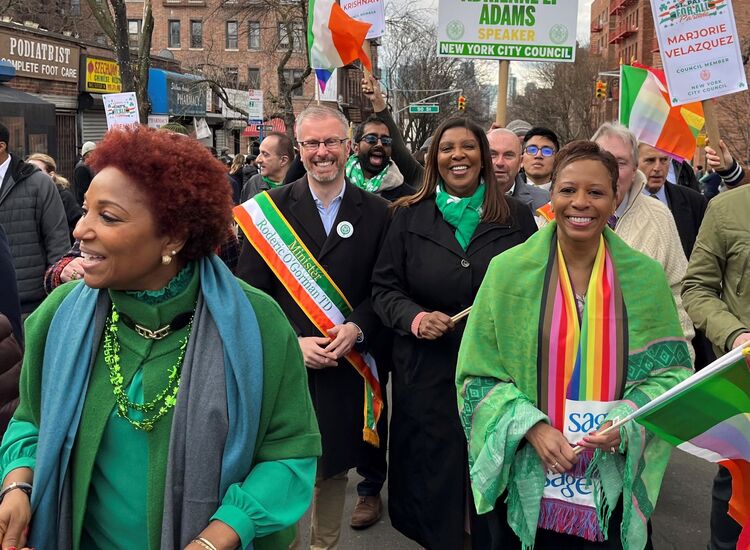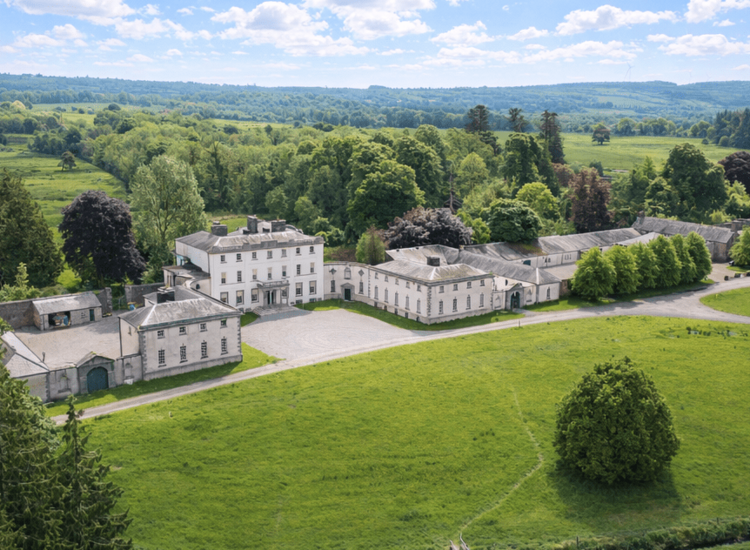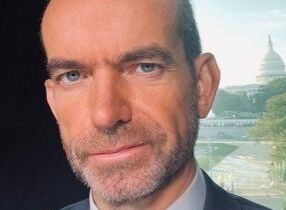
Keillor had a dry run at retirement in 1987 when he left weekly radio broadcasting for two years, intending to write more. Now he insists his retirement from "A Prairie Home Companion" will not be temporary, though he will remain its executive producer. Still, if the show begins to founder under a new host, as it did for a year under Noah Adams with a different title and format but in the same time slot, who knows?
Like Browning at WMI, Keillor has showcased several Irish and other Celtic traditional acts over the years on "A Prairie Home Companion." His roster of guests has included Altan, Solas, Dervish, Kevin Burke, John Doyle, Andy M. Stewart with Gerry O'Beirne, and the Battlefield Band.
But of all the Celtic traditional music acts Keillor has booked, none seems dearer to his heart or sensibility than the Boys of the Lough, co-founded in 1967 by Ballinaleck, Fermanagh, singer, flutist, and tin whistle player Cathal McConnell, the only original member still in this pan-Celtic band. The Boys of the "Luff," as Keillor often whimsically called them, have appeared numerous times on his show, so it was no surprise when the band asked him to emcee a 20th-anniversary concert for them at Manhattan's prestigious Carnegie Hall on Feb. 23, 1988. Another special guest that night was Bill Monroe and the Bluegrass Boys.
I was there, and I remember reading some reviews and wondering: Did the critics witness the same concert that I did?
Lasting seven minutes and forty seconds, Keillor's opening track on the CD recorded from that concert, "Boys of the Lough: Live at Carnegie Hall" (Sage Arts, 1989), is engaging but reveals only part of what he said that night. Omitted were his fairly dyspeptic remarks about Minnesotans, and I recall the audience's giggles yielding to awkwardness or confusion. Those particular comments of his were not funny, and after a while I had the uneasy feeling they were not meant to be.
The music performed on stage, however, was superb. But the premise of offering a Celtic traditional band and a bluegrass band in one concert to win over a larger crowd than each might otherwise attract did not work out exactly as expected. Because the Boys of the Lough were recording their performance for an album, they did a soundcheck last and performed first so that the engineers did not have to alter the settings on their equipment. As plainly heard on the CD, the Boys of the Lough--then comprising McConnell, Aly Bain, Dave Richardson, Christy O'Leary, and John Coakley--were in peak form.
But what disturbed me was a portion of the audience who had left for the rear lobby or bar to chat or drink while the band they didn't come to see was on stage. In other words, some fans of the Boys of the Lough disappeared on Bill Monroe and the Bluegrass Boys, and several more fans of the latter disappeared on the former. Instead of a projected, full, attentive audience for both, each band performed in front of a noticeably pared-down crowd.
What caused this rigidity or discourtesy? I'm still unsure, but what I became painfully aware of that evening was that several dyed-in-the-wool devotees of bluegrass or Celtic only wanted to see and hear their music. The musicians in both bands, to their credit, displayed nothing but mutual admiration and respect. They performed laudably, although I remember Bill Monroe, urged on by his fans, and the Bluegrass Boys staying on stage longer than the concert promoter had scheduled. Every minute past the prescribed end-time cost the promoter money. I know because he told me.
Days afterward, I discussed this odd reaction by segments of the audience with other concert organizers, who confided that two different-genre acts can result in half a crowd, literally or temperamentally. I've emceed at many festivals that featured a diversity of acts, including Celtic and bluegrass, and I never witnessed at those festivals what I witnessed at Carnegie Hall on Feb. 23, 1988. Twenty-three years later, the image of those willfully vacated seats for each band's performance still bothers me.
Nothing, however, could ever diminish my esteem for and enjoyment of the music made by Bill Monroe, the acknowledged Father of Bluegrass and an idol of mine, whose death at age 84 on Sept. 9, 1996, prompted my retrospective article on him in The Wall Street Journal. Nor could my enthusiasm and appreciation ever lessen for the music made by the Boys of the Lough. That's why I wholeheartedly recommend "Boys of the Lough: Live at Carnegie Hall," a CD of exceptional live Celtic traditional music prefaced by Garrison Keillor's undeniable wit. It's available on the band's own Lough Records (specifically, Lough 004) at www.boysofthelough.com.
Also, keep your fingers crossed that whoever eventually replaces Keillor as host of "A Prairie Home Companion," a radio show fully deserving its accolades and loyal audience, will continue to book the best in Celtic traditional and bluegrass music. ROAM tour In stark contrast to the partially dichotomous audience attending that 1988 Carnegie Hall concert, the capacity audiences for the dozen concerts of the "Roots of American Music" (apt acronym of ROAM) tour this month reveled in Irish, African, and Blue Ridge Mountain music, according to Limerick-born, Manhattan resident singer and multi-instrumentalist Mick Moloney, a tour member who phoned me from the road in southwest Virginia. The other 11 ROAM members were Southern California uilleann piper and bodhran player Joey Abarta, Lonesome River Band bluegrass banjoist and guitarist Sammy Shelor, third-generation Carter Family singer, guitarist, and autoharpist Dale Jett, Mali griot Cheick Hamala Diabate, Virginia singer, guitarist, banjoist, autoharpist, and flatfoot dancer Eddie Bond, Round Peak banjoist, guitarist, and fiddler Kirk Sutphin, Big Stone Gap singer Molly Slemp, Virginia gospel singer and bassist Linda Lay, Virginia singer and drop-thumb banjo player Burl Rhea, Virginia singer, guitarist, and luthier Wayne Henderson, and Virginia singer, guitarist, and banjoist Leigh Beamer. Conceived and organized by 73-year-old Joe Wilson, who retired in 2004 after 28 years as executive director of the National Council for the Traditional Arts, this "Roots of American Music" tour dipped into a rural southwest Virginia sound formed from the music of the Ulster Irish, Rhine Valley Germans, Africans, Blue Ridge mountain denizens, and others there after 1720. "Roots of American Music" is also the name of an exhibit at the 17,000-square-foot Blue Ridge Music Center overseen by Joe Wilson in Galax, Va. Moloney told me he was having a ball, and gave me this heads-up: 15-year-old Leigh Beamer has the talent to reach an Alison Krauss-like level of recognition.








